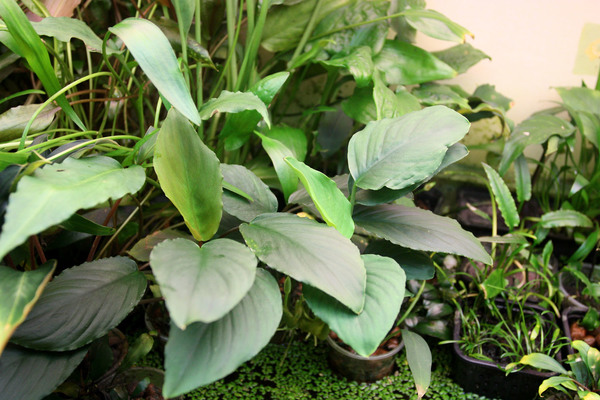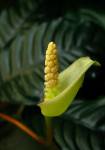A Rheophyte from Sumatra
Probably, each of you will find in your childhood memories how rich and amazing life was at that time. Every day brought many new discoveries. On the margin of an ordinary pond one could spend hours studying various dragonflies, snails, frogs and other living creatures. Or, lying on your back in the grass, you were peering into the shape of clouds running across the sky, performing a “heavenly” show that only you could understand. Unfortunately, as we get older, these things do not amuse us anymore, and sometimes we do not even notice them. But this nostalgia is deceptive. Man, by nature, always remains a researcher and, having learned some phenomena, starts searching for the new ones.
It is rare that an aquarist is content with only one type of fish or plant for several years. The irresistible craving for the unknown pushes him to obtain more and more new pets (Figure 1). However, at a certain point you realize that the range of living objects suitable for keeping in your fish tank is not so large. In addition, they are also systematically combined into groups (families, genera), the representatives of which have similar morphology and conditions of pet care. For example, plants of the Araceae family are represented in aquariums primarily by common Cryptocoryne and Anubias species. Moreover, you do not surprise anyone with Pistia or duckweed (In 2010, duckweeds were transferred from Lemnaceae into Araceae because the taxonomists had discovered an inflorescence of this single-leaf plants).
Figure 1. Home wet greenhouse with rare aroids from Southeast Asia.
In contrast to this, the appearance of some rheophytic aroids from the island of Kalimantan in aquariums looks revolutionary. In particular, Bucephalandra plants have rooted in the tanks of collectors in a short period and have been used even in aquascaping. It turned out that not only Kalimantan, but also the neighboring island of Sumatra is rich in surprises. Although, what new can this island offer except for the Sumatra barb (Puntius tetrazona) that has been one of the most popular fish among fish keepers for several decades?
Some months ago, Konstantin Pachomov from Moscow gave me a specimen of Furtadoa sumatrensis from Indonesia. Despite the fact that I have been interested in aroids for several years now, I did not even suspect the existence of this genus. The only association was the name of the famous Canadian singer Nelly Furtado, but it would be naive to believe that the plant was named after her.
A short search on the Internet clarified the situation. Apparently, the genus Furtadoa consists of only two species and is named after C.X. Furtado, a researcher of the flora of Southeast Asia, who was born in India (Figure 2). The name, by the way, is well known in our hobby; in particular, this man described Cryptocoryne nurii in 1935. It is symbolic that two years later Furtado held in his hands the plant that would be named in his honor only after the botanist’s death in 1981, but did not describe it in detail. He made only a modest assumption: “Perhaps this is a new genus.” The Japanese M. Hotta made a complete description of the new plant according to all the rules of modern botany during his expedition to the western part of Sumatra. For me, all these pallid statistics make me feel confused - why are we, aquarists, learning about the plant discovered and described more than 30 years ago only now?

Figure 2. Caetano Xavier dos Remedios Furtado (14 October 1897 – 13 June 1980). Genus Furtadoa was named after him by M. Hotta in 1981.
At the first moment after receiving F. sumatrensis, I had two answers to this question: the plant is difficult to cultivate at home, or the region where it grows is difficult to access for collectors. Looking ahead, I can say that the first version turned out to be completely unfounded.
I received the new guest from Sumatra in two forms, differing in the color of the petioles and young leaves - red and green (Figure 3). Externally, the plants looked similar to the Anubias of the Barteri group: small in size (height up to 20 cm), creeping rhizome, egg-shaped leaves extending from the rhizome on thin petioles.
Figure 3. Red (on the left) and green forms of Furtadoa sumatrensis in the home greenhouse.
I put both plants in my greenhouse with a nutrient solution. In this case, this choice was completely random - I was guided by the principle “Where there is free space, I plant it there.”
There is a misconception among nature lovers that greenhouse conditions are obviously better than aquarium conditions. In fact, this statement is not always true. For example, when we deal with rheophytes. This group of hydrophytes includes plants that grow in fast flows of water (Figure 4). In the wild, such biotopes have the following distinctive features: the constant chemical composition of water and its low hardness. These two conditions are the easiest to meet in an aquarium. The aquatic environment, due to its significantly higher viscosity and heat capacity compared to air, smoothes out almost any differences in living conditions. In addition, the mineralization of almost all greenhouse nutrient solutions is incredibly high (TDS = 500-1000 ppm), and not every plant is able to withstand the osmotic shock that occurs when moving into such an environment. That is why Bucephalandra plants are much easier to keep in an aquarium. According to the literature, Furtadoa sumatrensis is also a typical rheophyte growing on rocks along the banks of small streams with fast flows.
Figure 4. A typical biotope of rheophytic aroids as exemplified by Ooia kinabaluensis in the Liwagu River (Sabah, Malaysia).
Despite all the “buts,” both forms of Furtadoa perfectly adapted to the clay pellets provided to them as a substrate. The red variety with enviable consistency (once every week and a half) delighted me with a young red leaf, which, as it grew older, got more familiar green colors, through which a “girlish blush” was still visible. The green form, in addition to the increased leaf mass, bloomed continuously, forming inflorescence after inflorescence. Usually, abundant flowering slows down plant growth, but in this case it did not affect the growth rate in any way. At first, I tried to maintain the pH of the solution within 6.0-7.0, but the subsequent switch to water with a pH of 4.5 did not influence the plants, which demonstrates their extraordinary adaptive qualities.
At first, the inflorescence of Furtadoa does not evoke enthusiastic emotions. The spadix, the covering leaf (spathe) - nothing special (Figure 5). Many aquarists will say: “It is like Anubias.” In fact, this can be said about the inflorescences of almost all aroids. The most interesting things are hidden in the details.
Figure 5. Green form of Furtadoa sumatrensis with numerous inflorescences.
As we remember, monosexual flowers of Anubias are differentiated: female flowers are located in the lower part of the spadix, and male flowers are located in the upper part. For example, in Acorus, which also previously belonged to the Araceae family, the spadix is evenly covered with bisexual flowers. Furtadoa represents an intermediate evolutionary link between these plants. Its female and male flowers, although distributed along the entire length of the spadix, remain monosexual (Figure 6). At the same time, the female flowers at the top of the spadix, like the male flowers at the bottom, are sterile. They can be called rudiments that have lost their functions during evolutionary development from bisexual flowers to more perfect monosexual ones. However, in order to see all this, it is necessary to remove the spathe of the inflorescence, or at least a part of it - the guest from Sumatra turned out to be very “shy” and during the bloom, it opens only a small gap in the spathe for a short time.
Figure 6. Inflorescence of Furtadoa sumatrensis (green form), part of spathe artificially removed.
Vegetative shoots in Furtadoa appear from dormant buds on the rhizome, as in Anubias. The similarity with these African natives is so great that if not for the differences in the structure of the inflorescences, F. sumatrensis would be called the first “Asian Anubias”.
In an aquarium, the Sumatran rheophyte is an extremely unpretentious plant. In particular, the red form grows well and reproduces itself vegetatively in a wide range of water parameters (pH = 6.0-8.0, dGH 8-13°). In general, no CO2 supply is required. However, when it is present, silvery sparkles (Figure 7), characteristic of Bucephalandra, appear on the leaves. When kept in a greenhouse, such a “glamorous effect” cannot be achieved.
Figure 7. Red form of Furtadoa sumatrensis in the aquarium. Photo by Alexey Litvinov.






